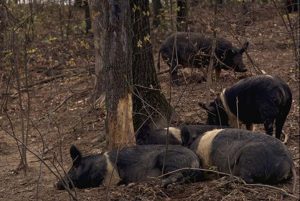 There are indeed wild pigs in the Northeast Florida. Florida’s wild hogs are often referred to as feral hogs or swine and are of three general types. The first type is the free-ranging swine from domesticated stock, the second are the Eurasian wild boar, and the third are hybrids of the two.
There are indeed wild pigs in the Northeast Florida. Florida’s wild hogs are often referred to as feral hogs or swine and are of three general types. The first type is the free-ranging swine from domesticated stock, the second are the Eurasian wild boar, and the third are hybrids of the two.
Although technically the term “feral” refers to free-ranging animals descended from domesticated stock, all wild hogs are typically referred to as feral in Florida, whether they descend from wild boar or from domesticated stock. Likewise, all wild hogs in Florida are considered the same species, Sus scrofa. Wild hogs are in the family Suidae (true wild pigs), none of which are native to the Americas.
Wild hog size and weight are variable, and depend on genetics and local conditions. Typically, male hogs (called boars) weigh 200+ pounds and stand 3 feet at the shoulder. Females, called sows are much smaller than male hogs.
Hogs have 4 continually growing, self-sharpening tusks (2 in the upper and 2 in the lower jaw; upper and lower tusks rub against each other, which keeps them sharp).
All wild hogs have an excellent sense of smell and good hearing, but relatively poor vision. Hogs prefer large forested areas with abundant food, particularly acorns, interspersed with marshes, hammocks, ponds, and drainages. The list of foods hogs eat is diverse and includes grass, forb, and woody plant stems, roots, tubers, leaves, seeds, and fruits, fungi, and a variety of animals including worms, insects, crustaceans, mollusks, fish, small birds, mammals, reptiles, and amphibians.
Humans are the main predators of wild hogs, but large carnivores such as alligators, black bears, and Florida panthers may be capable of preying on adult animals. Piglets are also preyed upon by smaller predators including foxes, coyotes, and bobcats.
Hunting is an important control method for wild hogs because it provides recreational opportunities, is inexpensive, and can be useful at reducing numbers of adult animals. Trapping is usually a better method of controlling hog numbers than hunting, especially when the animals are active at night.
For more complete information check out the UF/IFAS publication “Wild Hogs in Florida: Ecology and Management” from which I obtained the above information: http://edis.ifas.ufl.edu/uw322
 0
0
